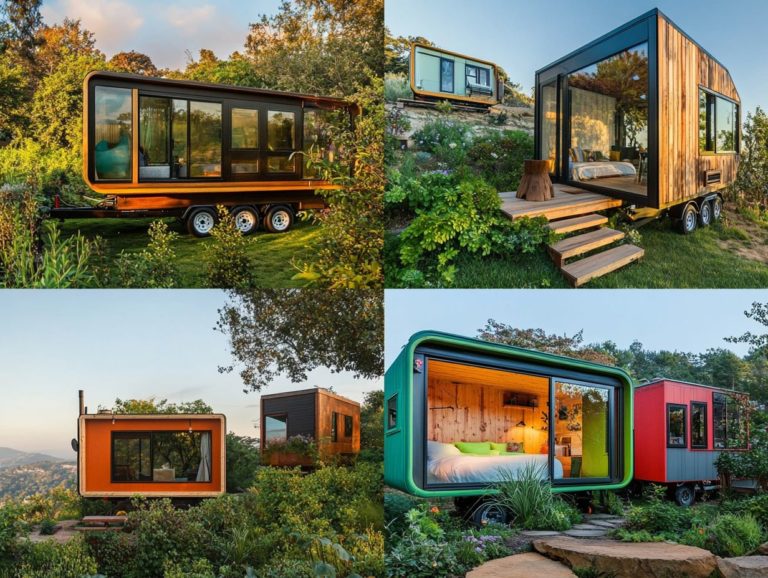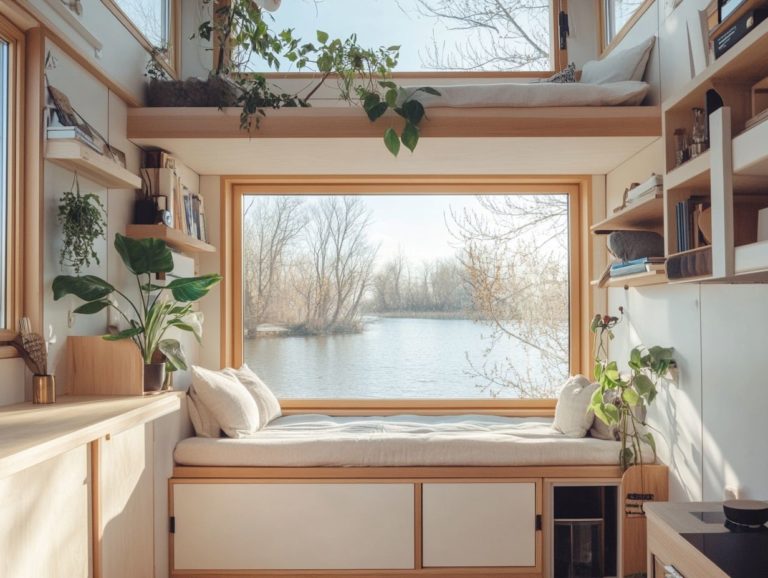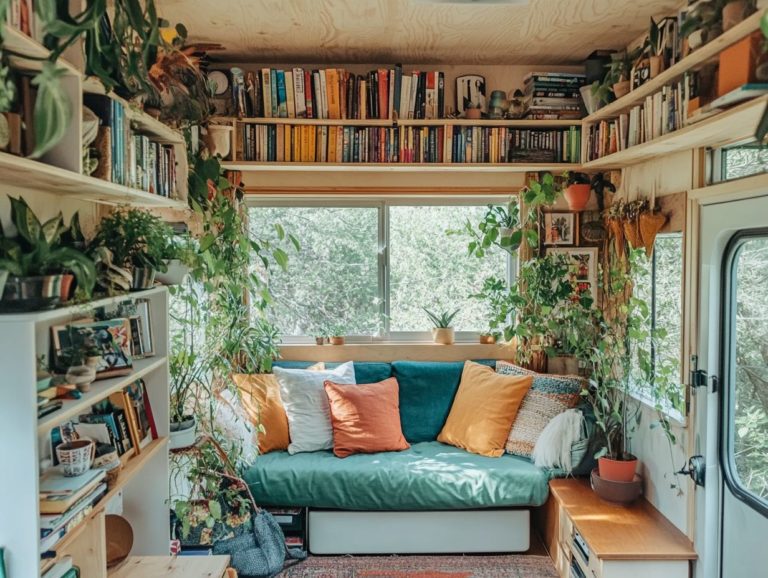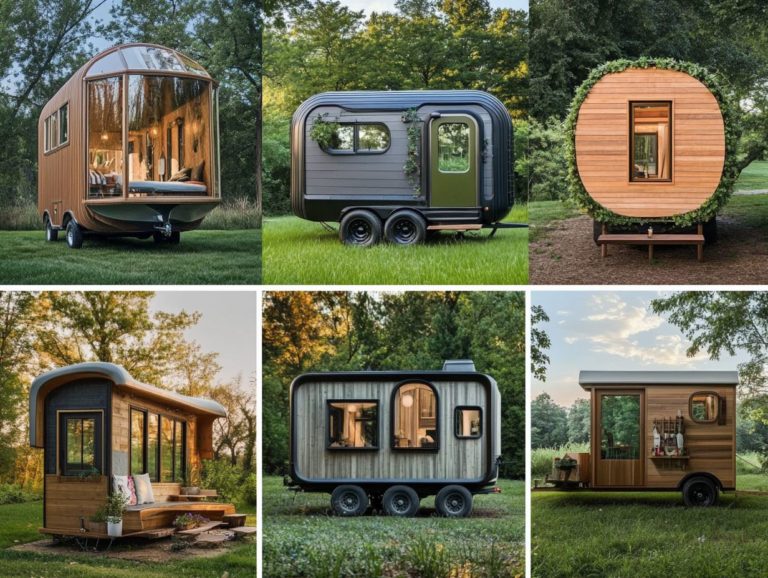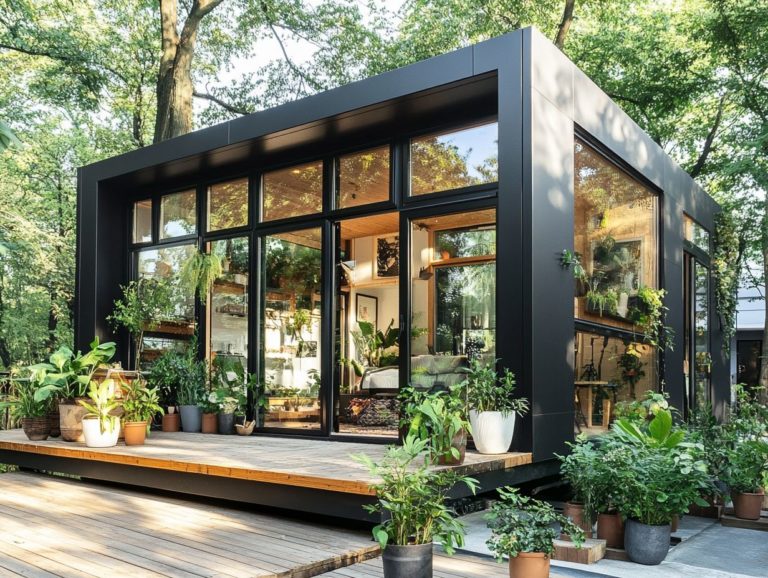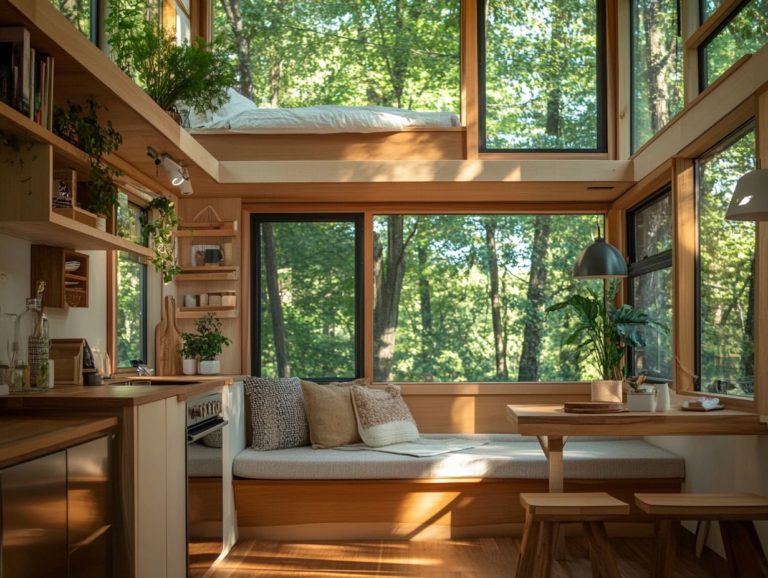Creating Outdoor Living Areas in Tiny Homes
Get ready to transform your tiny home into an exciting outdoor haven! Outdoor living areas can turn your simple dwelling into a vibrant, multifunctional sanctuary. By maximizing your limited outdoor space, you can enhance your lifestyle, creating inviting zones for relaxation, entertaining guests, and indulging in a bit of gardening.
This article explores the many benefits of outdoor living and provides design tips specifically crafted for tiny spaces. You ll find expert guidance on selecting the right furniture and decor to elevate your environment. You ll also discover budget-friendly DIY ideas and essential maintenance tips to keep your outdoor retreat inviting and durable.
Embrace outdoor living today and elevate your tiny home experience!
Contents
- Key Takeaways:
- Why Outdoor Living Areas are Important for Tiny Homes
- Designing Outdoor Living Areas for Tiny Homes
- Choosing the Right Furniture and Decor
- Budget-Friendly Options for Outdoor Living
- Maintaining Outdoor Living Areas in Tiny Homes
- Additional Tips and Tricks for Outdoor Living in Tiny Homes
- Frequently Asked Questions
- What is the benefit of creating outdoor living areas in tiny homes?
- What are some design ideas for creating outdoor living areas in tiny homes?
- How can I optimize small outdoor spaces in a tiny home?
- Can I still have privacy in my outdoor living area?
- What are some budget-friendly options for creating outdoor living areas in tiny homes?
- Are there any safety considerations for outdoor living areas in tiny homes?
Key Takeaways:
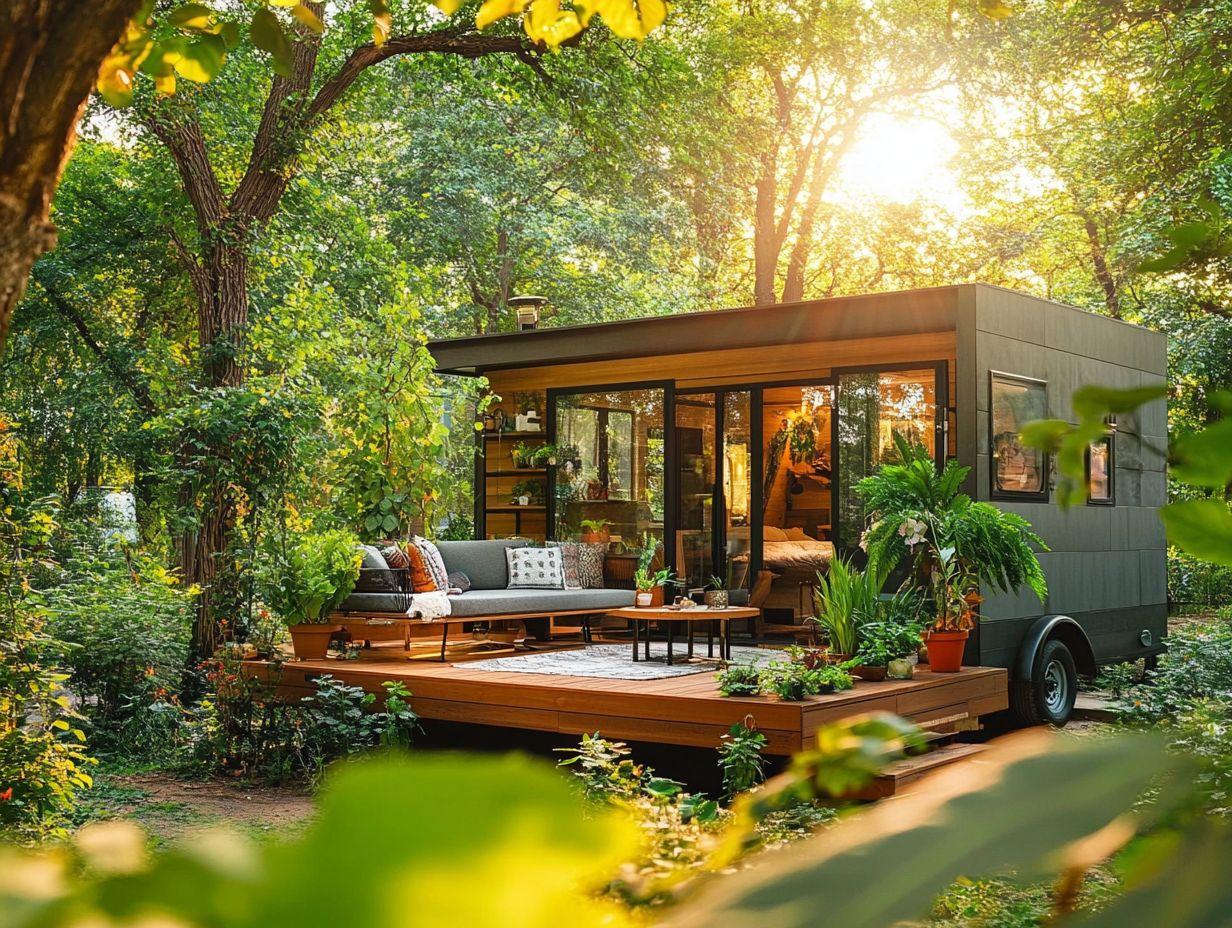
- Outdoor living areas are essential for tiny homes, providing additional space and a connection to nature.
- Designing outdoor living areas for tiny homes requires maximizing limited space and incorporating multi-functional features.
- Choosing the right furniture and decor, utilizing budget-friendly options, and maintaining the space can help create a functional and enjoyable outdoor living area in a tiny home.
Why Outdoor Living Areas are Important for Tiny Homes
Outdoor living areas are becoming essential for tiny homes, serving as a vital extension of indoor spaces. They allow you to embrace sustainable living while making the most of your outdoor surroundings.
As compact living gains popularity, these spaces offer a refreshing escape that encourages relaxation and fosters a sense of community among tiny home dwellers. By designing an outdoor living room, you not only boost your home’s curb appeal but also create opportunities for enjoyable recreational activities, making your tiny home feel more spacious and inviting. For more insights, explore the importance of outdoor spaces in tiny house design.
Integrating outdoor spaces into tiny house designs enhances a fulfilling lifestyle centered on simplicity and comfort, especially when incorporating nature into tiny house designs.
Benefits of Utilizing Outdoor Space
Utilizing outdoor space in tiny homes offers remarkable benefits that enhance your connection with nature, which is essential for fostering relaxation. You have the opportunity to create small gardens, vertical gardens, or cozy patios that elevate your outdoor living experience and contribute to a welcoming atmosphere.
This not only enhances visual appeal but also encourages community living, as shared outdoor spaces in tiny home communities promote interaction among residents. By designing functional outdoor areas, you can cultivate green spaces that boost biodiversity and support local wildlife. Exploring the art of tiny house landscaping can further enhance these outdoor environments.
These gardens can give you fresh produce and help you live sustainably, reducing the carbon footprint associated with food transportation. Outdoor spaces serve as ideal settings for relaxation and reflection, providing a serene escape from daily life.
When you engage in gardening or gather in communal areas, it strengthens social bonds, fostering collaborations on projects or events that enhance your collective living experience. The significance of these outdoor realms cannot be overstated; they transform tiny homes into vibrant communities and nurturing environments.
Designing Outdoor Living Areas for Tiny Homes
Designing outdoor living areas can be challenging but also very rewarding, especially when maximizing limited space while maintaining functionality and style. By prioritizing smart layouts and innovative landscaping ideas, you can transform your outdoor spaces into multifunctional areas perfect for hosting gatherings around a fire pit or crafting an outdoor kitchen for your culinary adventures.
Incorporating features like elegant deck designs and efficient water usage not only elevates aesthetic appeal but also enhances the practicality of these compact living environments.
Maximizing Limited Space
Maximizing the limited space in your tiny home calls for a touch of creativity and smart design choices that prioritize efficient use of outdoor areas. One effective approach is to implement vertical gardens plants grown on walls or hanging systems that save space on the ground. This enhances greenery and promotes eco-friendliness in those small outdoor settings.
Embrace low-maintenance landscaping ideas to enjoy your outdoor areas without the burden of excessive upkeep, making compact living much more enjoyable.
To further optimize these cozy outdoor spaces, thoughtful layout planning is key. You can create inviting seating areas or multifunctional decks that blend harmoniously with vertical gardens. Consider utilizing planters that double as seating to maximize functionality while maintaining aesthetic appeal.
Choosing native plants that thrive in your climate reduces water requirements, ensuring a sustainable garden that flourishes year-round. These strategic decisions elevate your outdoor experience and foster a deeper connection with nature, encouraging a healthier lifestyle while celebrating the principles of tiny living.
Incorporating Multi-Functional Features
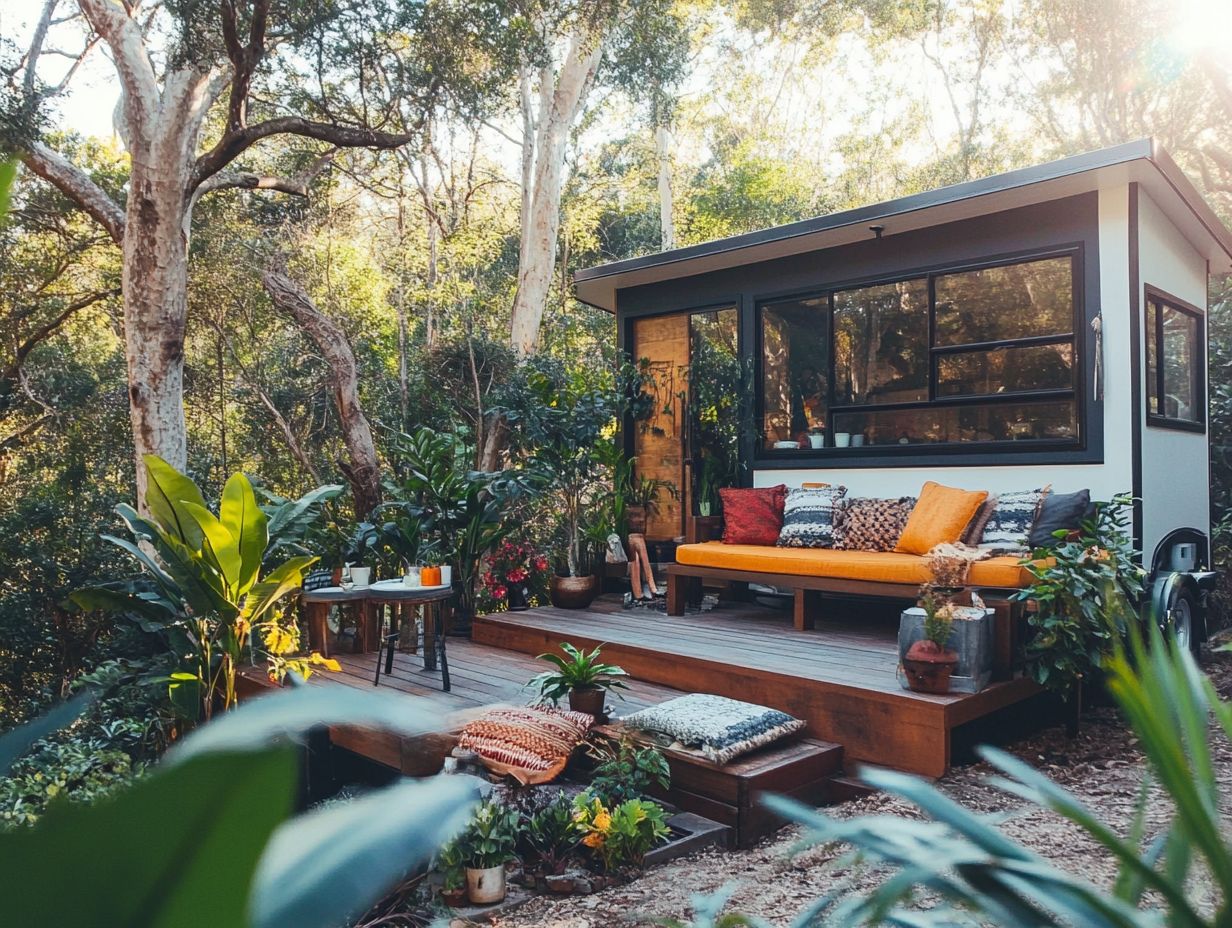
Incorporating multi-functional features into your outdoor living spaces is essential for optimizing functionality while maintaining comfort and style. By embracing foldable and versatile outdoor furniture, you can adapt your areas for various activities whether it’s hosting barbecues in a well-equipped outdoor kitchen or enjoying a cozy evening by the fire pit.
These space-saving solutions maximize your limited square footage and elevate the overall usability of your outdoor spaces.
Select items like collapsible tables and stackable chairs to transition effortlessly from everyday use to entertaining guests without sacrificing precious space. Integrate built-in storage options, such as benches with concealed compartments, to keep your area tidy while providing essential seating.
Pair these with multi-purpose fixtures, like an outdoor ottoman that doubles as a cooler, to create a seamless experience that enhances your outdoor enjoyment while preserving the intimate charm of your tiny home. For those interested in gardening, consider design tips for creating a tiny house garden. This smart design sparks community and relaxation, making your outdoor time unforgettable!
Choosing the Right Furniture and Decor
Selecting the perfect furniture and d cor for outdoor spaces in tiny homes is essential for crafting an inviting atmosphere that marries comfort with efficiency. Prioritize weather-resistant options to guarantee longevity while also embracing space-saving solutions that optimize the functionality of small dining areas.
Incorporate seasonal décor to infuse a personalized touch into your outdoor living spaces, transforming them into an extension of your home rather than just an afterthought. Consider designing a tiny house for entertaining to make the most of your space.
Space-Saving and Weather-Resistant Options
When selecting outdoor furniture for your tiny home, prioritize space-saving and weather-resistant options to ensure both durability and functionality. Opt for low-maintenance furniture to significantly elevate your outdoor experience, allowing you to savor your cozy atmosphere without the constant worry of upkeep.
Consider choices like stackable chairs and collapsible tables, which keep your outdoor spaces versatile and inviting, no matter the season.
In addition to these practical selections, think about incorporating multi-functional pieces, such as storage benches that double as seating. These not only help keep your area organized but also provide extra utility. Weather-resistant materials like aluminum or synthetic wicker are excellent choices, as they can withstand varying climates while adding a modern touch to your outdoor setting.
A bistro set with a compact footprint can transform even the smallest patio into a charming dining area. By embracing furniture that seamlessly blends style and practicality, you can maximize your outdoor enjoyment and turn limited spaces into vibrant extensions of your living areas.
Budget-Friendly Options for Outdoor Living
Budget-friendly options for outdoor living in tiny homes can elevate your experience while keeping your finances in check. By doing garden projects by yourself, you not only save money but also connect with your neighbors on projects that enhance shared spaces.
Thoughtful planning and creative solutions allow you to create inviting outdoor areas, ensuring comfort and style without straining your budget.
DIY and Upcycling Ideas
DIY and upcycling ideas offer innovative ways to personalize your outdoor living areas in tiny homes while being environmentally conscious. Jump into container gardening for a fun and practical way to grow herbs and veggies. Transform your space into a stunning seasonal showcase that enhances the charm of your outdoor environment. By repurposing materials, you can create a unique aesthetic that reflects your values and creativity.
For example, consider using reclaimed wood to craft stylish planters that add rustic charm to your garden. Pair that with colorful painted stones as plant markers for a whimsical flair. These projects not only spark your creativity but also allow you to express your personality through your outdoor spaces.
Embracing eco-friendly practices in your design minimizes waste and promotes sustainability, which is vital in today s world.
Seasonal decor, such as handmade garlands or wind chimes made from repurposed items, beautifies your area and fosters a sense of connection with nature, turning your outdoor experience into something truly special.
Maintaining Outdoor Living Areas in Tiny Homes
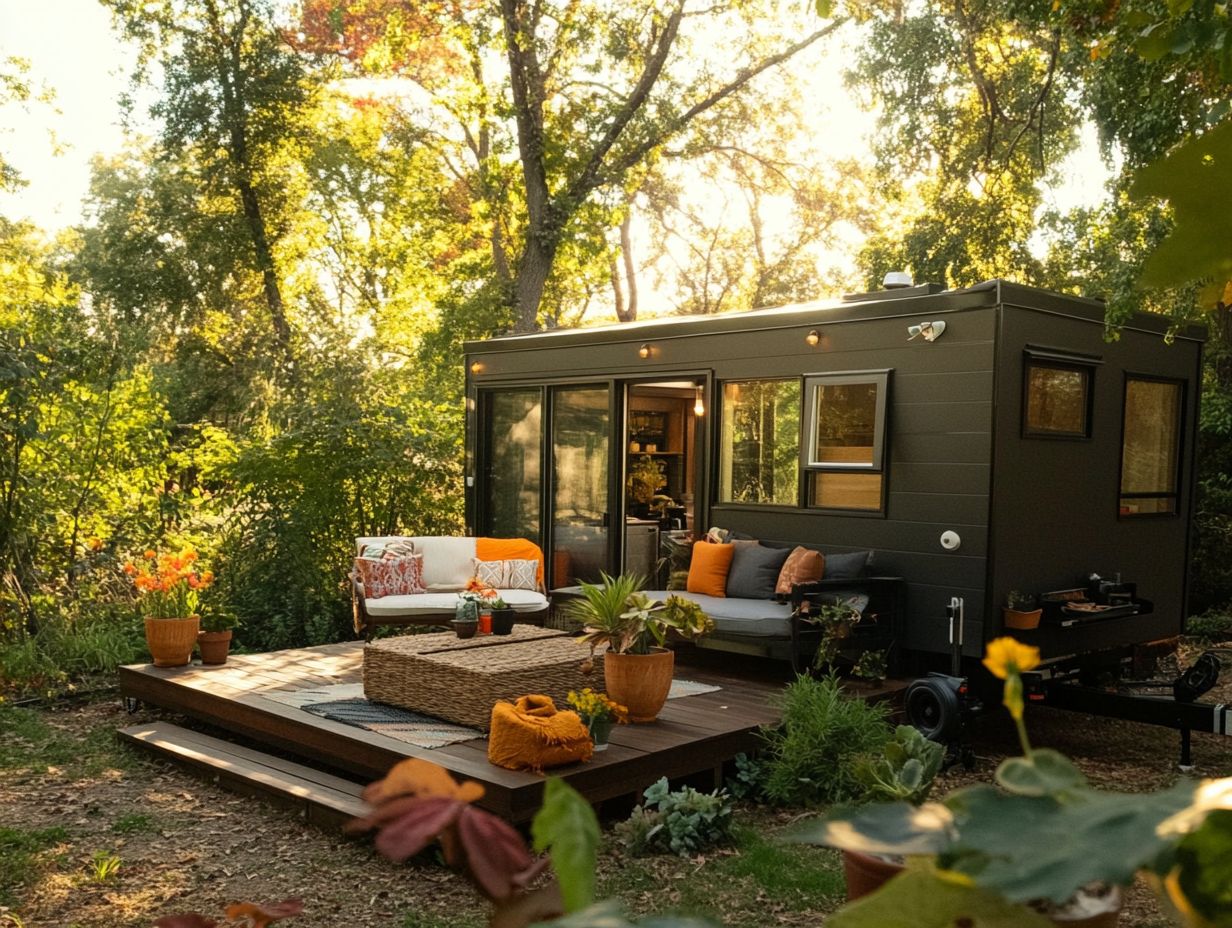
Maintaining outdoor living areas in tiny homes is crucial for ensuring their longevity and durability. Regular upkeep creates a comfortable and inviting space for you to enjoy. It also elevates the overall aesthetic, transforming your outdoor experience into something delightful.
By focusing on low-maintenance solutions, you can significantly reduce the effort needed to keep these spaces looking pristine, allowing you to fully embrace relaxation and enjoy your time outdoors.
Tips for Long-Term Use and Durability
For the long-term enjoyment and durability of outdoor living areas in tiny homes, focus on materials and designs that withstand the test of time. Choosing weather-resistant furniture, robust landscaping elements, and efficient water usage methods will enhance the longevity of your outdoor spaces.
Regular maintenance practices, like cleaning and making seasonal adjustments, are essential for ensuring you can enjoy your outdoor areas for years to come.
Incorporating composites or treated wood for decking can minimize wear and tear caused by the elements. It’s crucial to select high-quality fabrics that resist fading and mold for outdoor cushions and pillows.
Additionally, routinely check for signs of wear, such as peeling paint or rust, especially during seasonal transitions. Creating a seasonal maintenance checklist helps you tackle these issues promptly, ensuring your outdoor environment remains beautiful and functional throughout the year.
Additional Tips and Tricks for Outdoor Living in Tiny Homes
To elevate your outdoor living experience in a tiny home, consider incorporating greenery and natural elements that foster a serene atmosphere. By utilizing vertical space, you can maximize your outdoor areas, seamlessly integrating hanging planters and stunning landscaping features.
Use ambient lighting to transform these spaces into cozy retreats, perfect for evening gatherings or moments of solitary relaxation.
Incorporating Greenery and Natural Elements
Incorporating greenery and natural elements into the outdoor living spaces of tiny homes can significantly elevate their overall ambiance and aesthetic appeal.
Vertical gardens can turn your walls into lush, green backdrops. This transformation softens sharp lines and brings a calming feel to your space.
Container gardening offers the versatility to rearrange your plant displays with the changing seasons or simply on a whim. This ensures that each outdoor area remains fresh and inviting.
Plants improve air quality and lower stress. They help you connect with nature, making your outdoor experience more enjoyable. The vibrant colors and diverse textures of foliage harmonize beautifully with the structural elements of your tiny home. This creates a cohesive and welcoming retreat perfect for both relaxation and social gatherings.
Using Vertical Space
Using vertical space is an essential strategy for enhancing outdoor living areas in tiny homes, allowing you to optimize limited ground space effectively.
With this technique, you can cultivate lush gardens and vibrant atmospheres even when floor area is at a premium. For example, consider establishing vertical gardens with wall planters; this transforms bare walls into captivating green backdrops that breathe life into your space.
Outdoor shelving can also serve as a platform for ornamental pieces or functional tools, helping you keep clutter off the ground. These methods create an inviting environment that encourages relaxation and enjoyment in your outdoor areas.
Through innovative space management techniques, you can achieve both practicality and style.
Frequently Asked Questions
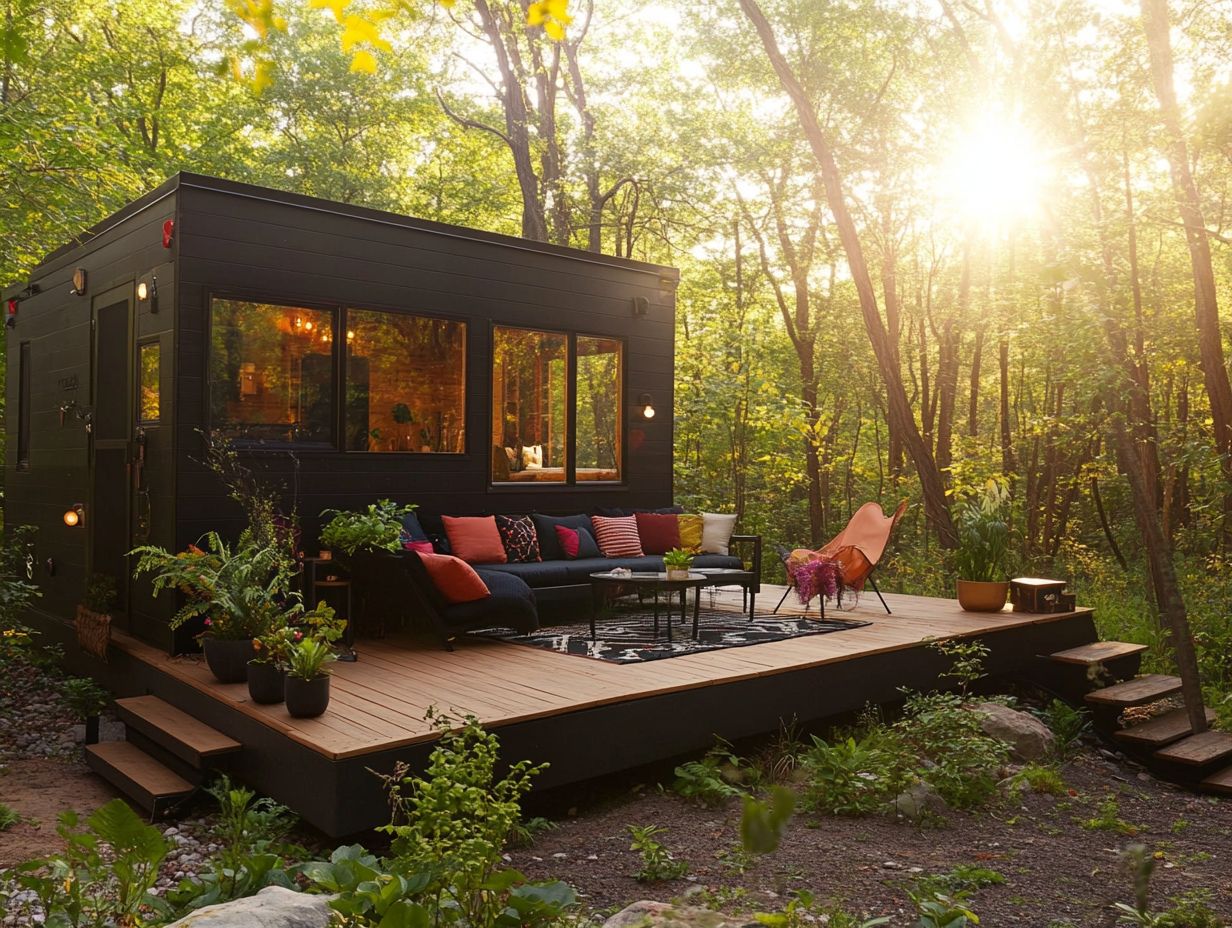
Here are some common questions about outdoor living areas in tiny homes:
What is the benefit of creating outdoor living areas in tiny homes?
Creating outdoor living areas in tiny homes can greatly expand usable space and provide a connection to nature. It can also make the tiny home feel larger and more open.
What are some design ideas for creating outdoor living areas in tiny homes?
Some design ideas include adding a deck or patio, incorporating multi-functional furniture, and using vertical space for gardening or decor.
How can I optimize small outdoor spaces in a tiny home?
Optimizing small outdoor spaces can be done by carefully planning the layout, using space-saving furniture, and incorporating dual-purpose features like a fold-down table or bench.
Can I still have privacy in my outdoor living area?
Yes, privacy can be achieved by adding a privacy screen, using strategic landscaping, or utilizing curtains or shades on a pergola or deck.
What are some budget-friendly options for creating outdoor living areas in tiny homes?
Budget-friendly options include using salvaged materials, upcycling furniture, and DIY projects such as building a pallet deck or creating a container garden.
Are there any safety considerations for outdoor living areas in tiny homes?
Yes, safety considerations include properly securing furniture and structures, using slip-resistant materials, and following fire safety guidelines for grilling or using fire pits.

